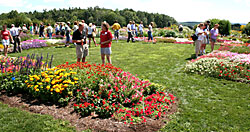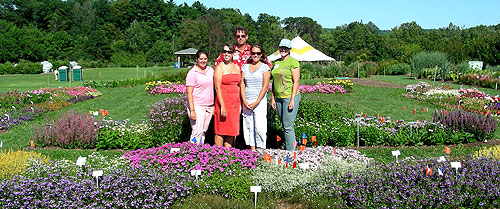About 2006 evaluations
 Floriculture Field Day attendees view annual flower trials at Bluegrass Lane. Larger image. |
2006 Vegetative and Seed Annual Evaluations
Bill Miller wbm8@cornell.edu
Horticulture Section, School of Integrative Plant Science, Cornell University, Ithaca NY
Background. We are now in the third year of our "annual" evaluation program. We provide valuable information on plants that are currently available, as well as those not yet released. This information is used by the industry to develop better plants for consumers. Better plants mean happier consumers, and potentially more sales. Varieties were entered from 7 sources:
- Ball Horticultural Company (10 entries)
- Ball FloraPlant (11 entries)
- Fischer USA (14 entries)
- Goldsmith Seeds (66 entries)
- Pan American Seed (11 entries)
- Proven Winners
- S&G Flowers (5 entries).
Seed, plugs, or rooted cuttings were grown in 4” pots in the spring, and transplanted at the Bluegrass Lane Research site in early June. Beds were heavily amended with mushroom compost. Maintenance was minimal (mulching, weeding and some grooming). Fertilizer was applied as a dry feed in mid-June(Osmocote). Irrigation was applied via overhead sprinkler/hand-watering all season long. Ithaca (Zone 5A) had a rather normal season as far as temperatures. June's average high was 74F, July's was 81F, and August's was 78F. What was unusual was the amount of precipitation. Both June and July had almost doulbe the normal amounts of rain, at 7 1/2" and 6 1/2" respectively. August was drier, being only moderately higher than normal with 4 1/2". Because of all the extra rain, fungi flourished. Botrytis afflicted many cultivars of petunias, while slime molds seemed to be less discriminating. Additional weather information can be found at The Ithaca Climate Page.
Evaluation Criteria. Plants were evaluated independently at 2 week intervals by 5 people. Plants were given a 1-5 rating (1 = awful, 5 = great) on the following attributes:
- Flowering impact
- Foliage appearance
- Plot uniformity
- Overall landscape value
These numbers were then averaged across all raters, for all evaluation dates, giving an overall seasonal average. Thus, the Average of "overall" criteria is the average of 96 individual ratings (the 4 items listed above, each from 4 people, on 6 different evaluation dates). In the table, we have grouped plants together, then sorted from best to worst based on the total seasonal average performance. The individual cultivar profile pages also list comments made by the raters and pictures.
Thanks are expressed to the breeding and supply companies who provided plant materials and financial support for these trials. These trials would not have been possible without the great efforts of Ron White and JC Mosher of the Cornell Turfgrass and Landscape Research Lab, my Trial Garden Coordinator Melissa Kitchen, former undergraduate students Stephanie Whitehouse and Jen DeStefano, current undergraduate students Cheni Filios and Maria Stager, and last but not least Annie Wiiki.

Left
to right: Cheni Filios, Stephanie Whitehouse, Bill Miller, Maria Stager,
Melissa Kitchen
Recognition. Due to requests from the industry and to facilitate use of this site by the public, this year we are implementing a recognition system.
Two classes of recognition are being employed--- "Best Overall"
and "Best in Category." These titles will be used to highlight
the top ten performing plants of the season ("Best Overall"- ![]() )
as well as the best performing plants within individual plant categories
("Best in Category"-
)
as well as the best performing plants within individual plant categories
("Best in Category"- ![]() .) View pictures of the 'bests'.
.) View pictures of the 'bests'.
Awarding of titles is based on a numerical score that reflects the plants performance throughout the entire growing season. Plants were subjectively rated, as described above in Evaluation criteria above. It should be indicated that some plants peaked at certain points in the growing season, while the performance of others was continually strong. As our research site is in full sun, some plants might have performed better in part shade conditions. Lastly, these comparisons and conclusions are made based on the entries that were independently submitted by participating companies.
© Copyright by the Horticulture Section, School of Integrative Plant Science, Cornell University.
More info about flower research, contact:
Dr. William Miller
Horticulture Section
School of Integrative Plant Science
135 Plant Science Bldg.
Cornell University
Ithaca, NY 14853
607-255-1799, Fax: 607-255-0599
Email: wbm8@cornell.edu


